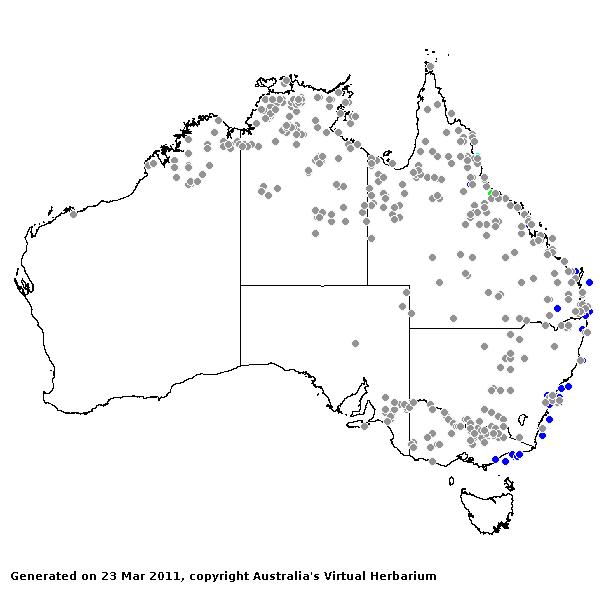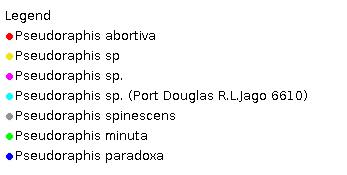Pseudoraphis Notul. Pl. Asiat. 3: 29 (1851).
Derivation:. From Greek pseudo (false) and genus Raphis.
Taxonomic revisions, nomenclatural references:. J.W.Vickery, Proc. Roy. Soc. Queensland 62: 69–72 (1952).
Key references (keys and floras):. C.A.Gardner, Flora of Western Australia 1 Gramineae 238–240 (1952); E.E.Henty, Manual Grasses New Guinea 165 (1969); J.W.Vickery, Flora of New South Wales, Gramineae 19: 211–214 (1975); M.Lazarides, Tropical Grasses S.E. Asia 137–138 (1980); M.Lazarides, Flora of Central Australia 482 (1981); J.C.Tothill and J.B.Hacker, Grasses of Southern Queensland 360–361 (1983); J.P.Jessop, Flora of South Australia 4: 1975–1976 (1986); R.D.Webster, Australian Paniceae 195–199 (1987); T.D.Macfarlane, Flora of the Kimberley Region 1213 (1992); B.K.Simon, Key to Australian Grasses 153 (1993); S.W.L.Jacobs and S.M.Hastings, Flora of New South Wales 4: 490 (1993); D.Sharp and B.K.Simon, AusGrass (2002); J.P.Jessop, Grasses of South Australia 474–476 (2006); S.W.L.Jacobs, R.D.B.Whalley & D.J.B.Wheeler, Grasses of New South Wales, 4th ed, 357–358 (2008).
W.D.Clayton & S.A.Renvoize, Genera Graminum (1986), genus (530).
Native. 7 species, from India and Japan to Australia. 4 species in Australia, WA, NT, SA, Qld, NSW, and Vic. Also New Guinea and Malesia.
Habit. Perennial, decumbent. Leaf blades narrow. Ligule an unfringed membrane.
Inflorescence. Inflorescence of spicate main branches (the slender flexuous branches sometimes reduced to one or two spikelets), a spike-like panicle or a racemose panicle with spikelets all similar, non-digitate. Spikelet-bearing axes much reduced (with only one spikelet) or racemes (with a compressed peduncle, the few spikelets distant).
Spikelets. Spikelets dorsally compressed, 2 flowered, with 1 fertile floret, with raceme axis extending into a bristle, solitary, shortly pedicelled. Fertile spikelets with lower incomplete floret(s), lanceolate, abaxial (with lower glume on side away from rachis), falling with glumes, with distinctly elongated rachilla internodes between florets. Upper floret borne on a swollen stipe. Stipe beneath upper floret not filiform.
Glumes. Glumes unequal, (the longer) long relative to adjacent lemmas, awned or awnless (upper glume acuminate to awnlike above), dissimilar (lower tiny, semiorbicular, rectangular or broadly obovate, the upper lanceolate, acuminate or tapering into an awn). Lower glume 0 nerved. Upper glume 5–9 nerved.
Florets. Lower incomplete floret(s) male. Lemmas awnless or awned (sometimes awnlike above), 7–13 nerved, exceeding fertile lemmas (similar to the upper glume in shape), less firm than fertile lemmas to similar in texture to fertile lemmas, not becoming indurated. Fertile florets 1. Lemmas similar in texture to glumes to decidedly firmer than glumes, smooth, becoming indurated (slightly) or not becoming indurated, white in fruit, entire at apex, muticous, 0 nerved, glabrous, having flat margins not tucked into palea. Palea relatively long, obscurely nerved. Lodicules 2. Stamens 3 or 0 (usually rudimentary or missing). Grain small, compressed dorsiventrally. Hilum short. Embryo large.
Kranz Anatomy. C4.
2n = 16.
Habitat. Hydrophytic to helophytic. Marshes. Species of open habitats.
Classification. Panicoideae; Paniceae.
Types Species. P. brunoniana (Griff.) Griff.
Biogeographic Element. Clifford & Simon 1981, Simon & Jacobs 1990: Indo-Malayan.


